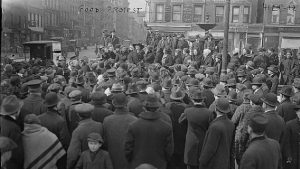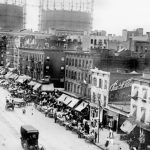 Creepy
Creepy  Creepy
Creepy  Technology
Technology 10 Scientific Breakthroughs of 2025 That’ll Change Everything
 Our World
Our World 10 Ways Icelandic Culture Makes Other Countries Look Boring
 Misconceptions
Misconceptions 10 Common Misconceptions About the Victorian Era
 Mysteries
Mysteries 10 Strange Unexplained Mysteries of 2025
 Miscellaneous
Miscellaneous 10 of History’s Most Bell-Ringing Finishing Moves
 History
History 10 Great Escapes That Ended Right Back in Captivity
 Weird Stuff
Weird Stuff 10 Fascinating Things You Might Not Know About Spiders
 Food
Food 10 Everyday Foods You Didn’t Know Were Invented by the U.S. Military
 History
History 10 Odd Things Colonial Americans Kept at Home
 Creepy
Creepy 10 More Representations of Death from Myth, Legend, and Folktale
 Technology
Technology 10 Scientific Breakthroughs of 2025 That’ll Change Everything
 Our World
Our World 10 Ways Icelandic Culture Makes Other Countries Look Boring
Who's Behind Listverse?

Jamie Frater
Head Editor
Jamie founded Listverse due to an insatiable desire to share fascinating, obscure, and bizarre facts. He has been a guest speaker on numerous national radio and television stations and is a five time published author.
More About Us Misconceptions
Misconceptions 10 Common Misconceptions About the Victorian Era
 Mysteries
Mysteries 10 Strange Unexplained Mysteries of 2025
 Miscellaneous
Miscellaneous 10 of History’s Most Bell-Ringing Finishing Moves
 History
History 10 Great Escapes That Ended Right Back in Captivity
 Weird Stuff
Weird Stuff 10 Fascinating Things You Might Not Know About Spiders
 Food
Food 10 Everyday Foods You Didn’t Know Were Invented by the U.S. Military
 History
History 10 Odd Things Colonial Americans Kept at Home
Ten Uprisings Led by Women
Not all uprisings, revolts, and revolutions are led by men. You may think that’d be the case judging from the most notable moments of revolt in history. Still, women have had a surprisingly important role in many underdog uprisings. All throughout human history—especially in the last couple of centuries—when women have gotten fed up about something, they’ve shown they can take collective action to end it. In this list, we’ll learn all about ten of those stories.
These are the fascinating and inspiring tales of ten times women got together and put on an uprising with the express hopes of making life better for themselves, their communities, and their families. Truly, this is what they mean when they say “girl power.”
Related: Top 10 Prisoner Riots and Revolutions in History
10 Boudica
The Iceni tribe was an indigenous group of British Celtic people mainly living happily and successfully on the British Isles before and just after the birth of Jesus Christ. But things turned sideways when the Romans showed up and tried to take control. The Iceni people didn’t care for how the Romans ran their society and were overbearing and pushy toward the locals. So they turned to a powerful woman to help rid them of the Roman presence.
Her name was Boudica, and she was a notable queen of the Iceni tribe. In AD 60–61, she led an uprising against the Roman Empire’s conquering forces on the British Isles. The Romans were shocked at the aggressiveness displayed by the queen in the motivation of freeing her people. The Romans were caught on their heels for months, and Boudica and the Iceni people made major headway.
Unfortunately for her, the uprising eventually failed. After that, she was said to have poisoned herself to death. Today, though, she is considered a British folk hero for what a courageous job she did leading an uprising against the powerful Romans.[1]
9 French Revolution
Women were extremely prominent during the French Revolution. Most notably, they were active in the food riots in French marketplaces in cities and towns. The most notorious of these was the Women’s March on Versailles in October 1789. During that incident, the market women of Paris began calling the men “cowards” and declared their intention to take over the revolution. They then marched all the way over to Versailles with soldiers following them.
The crowd of women was so boisterous and loud that it forced the king to return to Paris and deal with the situation. Then, three years later, women were again major participants in the eventual acts that destroyed the French monarchy completely. They were so vicious and powerful during the Revolution that years later, local observers recalled how it had come to pass. “It is mainly the women who are stirred up,” one police inspector said in 1793 of the women’s role in the French Revolution. “Women who in turn communicate all their frenzy to the men, heating them up with their seditious propositions and stimulating the most violent effervescence.”[2]
8 British Suffrage Movement
During the early twentieth century, the British women’s suffrage movement was pushing forward in full force. Women protested en masse for the right to vote. While that happened in many places across the world (including the United States), it was extremely pronounced and even violent in Britain.
There, the women who led the suffrage movement used aggressive and demanding strategies to get the right to vote and get the attention of the powers that be. They didn’t just march in a variety of peaceful mass demonstrations. Instead, they committed acts of arson, very infamously broke windows all over Britain to show their displeasure, and stormed both Parliament and Buckingham Palace.
Ultimately, women got what they wanted—but it took a while. This was partly because the British women’s suffrage movement paused their protests right when World War I broke out in 1914. They recognized that it was more important for everyone to help focus on the war effort for the time being, only to return to what they wanted later.
It’s quite impressive, really. Not only did the women call out the shortcomings in their society in an aggressive way, but they did so while being very mindful of the world’s forces swirling around them.[3]
7 World War I Food Riots

During World War I, women organized all kinds of food riots all over the world. While the men were busy with the war effort and fighting in the trenches in large numbers, women were at home and fighting against their governments over how expensive food had become—and how scarce. Women were fed up with how much it cost to feed their families and children.
While they knew and understood that a war was going on, they were also enraged at how difficult it was to get food for their starving little ones. So they took action by taking to the streets and demanding change. They held demonstrations, attacked shops and warehouses, and descended upon government offices to force local leaders to supply them with more and better food.
Those riots occurred in many places, including Germany, Russia, Italy, and other nations like Japan and Spain. But for the Americans, they were most notably felt on the morning of February 20, 1917. That day, more than 400 angry mothers ran up the steps of New York City’s town hall with their babies on their hips. They shouted, “We want food for our children,” in both English and Yiddish as they clambered into city hall and forced leaders to hear their pleas.
City officials were thrown off by the action, not expecting the women to be so aggressive and demonstrative with their men off fighting in the war. But that’s exactly what happened—and it left New York leaders reeling and looking for immediate solutions.[4]
6 The Indian Rebellion of 1857
In 1857, Indian people living under the colonial rule of the United Kingdom and the challenging conditions of the British East India Company rebelled. The rebellion came to be known simply as the Indian Rebellion of 1857, though it has since been called other names. It lasted until 1858, when it was finally put down, but it had long-lasting effects.
And the most notable part was that the Rani (or queen) of Jhansi, Lakshmi Bai, was one of the foremost figures of the rebellion who propelled it ahead with her strong leadership. In the end, the Rani of Jhansi became a major symbol of resistance to the British Raj and would, for decades afterward, be a heroic avatar for Indian nationalists.
The rebellion began on May 10, 1857, in the garrison town of Meerut, which was just northeast of Delhi. It quickly erupted into further rebellions and mutinies all across the region and throughout central India. It took the British Army about 13 months to squash the uprising, which was so successful that it left them reeling.
The British were left so badly on their heels, too, that they eventually had to grant amnesty to all Indians who were not involved in murders during the rebellion just to be done with it. The woman behind it all, the Rani of Jhansi, ended up dying at the very end of the rebellion on June 18, 1858, at Gwalior. However, she was memorialized for being one of the first and most vicious freedom fighters in India’s nascent history.[5]
5 The Montgomery Bus Boycott
The now-infamous Montgomery Bus Boycott was a notable social protest led by women. As history classes have hopefully taught you, the boycott began on December 5, 1955, after a black woman named Rosa Parks was arrested when she refused to surrender her seat on a city bus to a white person.
Over the next 55 weeks, women all over the Alabama city boycotted the rulings of the local public transit program, which stated that Black people had to give up their seats to white people or go to the back of the bus. Parks wasn’t the only woman involved, either; more than a dozen notable women led the boycott and demanded action to make things equal for everyone, regardless of race.
The boycott eventually ended on December 20, 1956, when the federal ruling Browder v. Gayle took effect. In turn, that led to a groundbreaking United States Supreme Court decision that declared that the state of Alabama and the city of Montgomery had unconstitutional laws regarding their position on where Black people were allowed to sit on city buses. And it all started with Rosa Parks and other women who were fed up with being discriminated against while using city services![6]
4 The Abeokuta Women’s Revolt
The Abeokuta Women’s Revolt is sometimes called the Egba Women’s Tax Riot. It occurred in the late 1940s after women in Nigeria who were part of the Abeokuta Women’s Union (AWU) became fed up with how they were being taxed by the Nigerian colonial government led and controlled by the British.
Basically, the British had levied a flat tax against women in Nigeria, which the women of Abeokuta very much didn’t like. They believed that their economic opportunities were decreasing, too, even though they were being taxed much more than before. So they decided to revolt against the British and fight back against the unfair flat tax they’d been ordered to pay.
In a series of protests, the AWU demonstrated against the British authorities and demanded several things. For one, they were sick of paying a tax that men didn’t have to pay. Second, they felt taxes, in general, were far too high. Third, they wanted seats on local government councils so they could have a say in the governance of their communities just like the men had.
In the end, the British colonial government granted that move in a landmark decision. The AWU got four seats on the local Abeokuta council, and the taxation of women was quickly and definitively ended. The demonstrations that those brave women in the AWU led had far-reaching consequences for Nigeria’s eventual push to shed the British altogether and pursue self-governance, too.[7]
3 Peru Food Revolt
In 2008, more than one thousand women protested outside the National Congress in Peru. They banged empty pots and pans and showed their great displeasure at their hapless government over the exorbitant costs of food. Those prices had been squeezing poor people worldwide for some time by then, but the Peruvian women took more direct action than most and got all the headlines for it.
With their small children being toted on their hips, they demanded the government step up to slow the surge in food prices. Many of the women were leaders of food kitchens and eating halls that feed the poor. But they’d been getting squeezed for months and found it very difficult to feed Peru’s growing population of poor people.
In turn, the women sank then-President Alan Garcia’s approval rating to just 26% due to the food issues. However, President Garcia was so moved by and scared of the massive women’s protest that he eventually took action. For one, he drastically cut taxes on food imports. Then, in a second follow-up, he ordered the army to go all across the country and begin handing out bags of food in the poorest neighborhoods and communities. And it was all because of the women in Lima who stepped up and made their voices heard.[8]
2 Iranian Protests
On September 13, 2022, a woman named Mahsa Amini was arrested by Iran’s Guidance Patrol, which covers morality and decency in public. She allegedly violated Iran’s mandatory hijab law by wearing her hijab “improperly” while she was visiting Tehran. Guidance Patrol officers then reportedly beat her severely, according to eyewitnesses.
She later collapsed from the beating, was hospitalized, and died three days later. Soon after that, protests spread from Amini’s hometown of Saqqez and flourished all across the country. The Iranian government was horrified by the protests and responded by putting out widespread internet blackouts and nationwide restrictions on social media usage.
In turn, women led real-world protests all over Iran to voice their displeasure over Amini’s mistreatment and death. Nationwide, university students, wives, mothers, and everyone else from varying social classes all coalesced to protest against the Iranian government’s stronghold over women’s rights and women’s issues in the nation.
At least 550 people were killed in the protests, including dozens of children. Thousands more people were arrested by the Iranian government and sent to detention. Women were the backbone of the protests, organizing them across communities and getting people out of their homes to show up and fight for their rights. Worldwide, the Iranian government was criticized mightily for its oppressive response to the women who stood up for themselves following Amini’s tragic death.[9]
1 The Women’s March
On January 21, 2017—the day after Donald Trump was inaugurated to become the president of the United States—millions of men, women, and children all over the country and the world marched to protest the backsliding of women’s rights. They were protesting in Washington, D.C., against President Trump, most notably.
However, the Women’s March, as it came to be known, sprung up everywhere. More than 680 marches were held throughout the United States, with others occurring in dozens and dozens of countries across the world. D.C.’s “flagship” march alone saw more than one million people attend.
When the dust had settled, estimates held that more than three million people worldwide attended marches in cities to protest President Trump and show support for women and women’s rights. They were nearly all led by women, too. The fairer sex was more affected by the Trump presidency than they had been under previous regimes from recent history. So they wanted to make it known that they objected to how they were being viewed and treated.[10]








